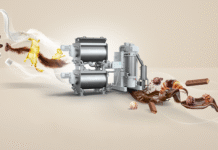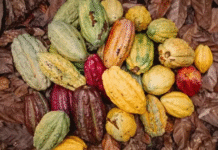
Visiting Metpack for the third time after a gap of six years reveals a new perspective for an industry that has become niche (read small and slow growing) compared to the rest of the packaging industry. Metal packaging is a stubborn and self-confident segment worldwide and not as small as one might have guessed. It represents US$ 108.8 billion in 2020 and, according to research firm Global Opportunity Analysis, is expected to reach US$ 147.4 billion in 2030 with an average growth rate of 3.1% between 2021 and 2030.
The seeming or possible resurgence of metal packaging is broadly characterized by three things – the growth of a wealthy consumer class in developed and emerging economies that uses it for personal care, food, and beverage products. In developed economies, the higher cost of steel or aluminum is easily borne upfront by mass consumers while in emerging economies metal packaging makes products more expensive and is thus used for luxury products such as smaller and smaller cans of beverages – in these markets, it is a badge of youth, status, and wealth.
The second possible cause of the resurgence is what Metpack is mainly about – technology. Metal containers have become lighter and thinner, and the coatings, sealants, caps, and closures have become handier and more elegant. The processes of containment, preservation, and logistics have become more efficient.
The coating and decoration technology has become snappier and more efficient using new plasma surface treatments, lacquers, inks, and haptic coatings with the inherent base material for the metallic looks and texture that all other packaging is hankering after. Digital printing has made small runs for craft beer and small wineries possible.
Alexander Hinterkopf, the managing director of the company by that name that manufactures the digital presses for cans, said yesterday about the resurgence of metal packaging, “metal has become sexy again.” We have seen the Hinterkopf digital can printing machines at three Metpacks now (and there was also an Italian competitor at the last show six years ago) but for the company founded in 1980, there is currently some market traction with its new generation print heads capable of 1800 dpi. However, improvements based mainly on better inkjet arrays imply that as soon as the concept of small directly printed tubes and containers catches on, there may be competitors.
This brings us to the third impetus for the current wave of optimism in an industry that generally seems reconciled to remaining a niche – a special and specialized industry quite in harmony with the practices of metalworking and comfortable that it is as indestructible as the material it uses. “Metal is always superior” for packaging, said Hinterkopf at the opening Metpack conference. The third impetus is related not only to the metal’s superiority as a container but its recyclability and its higher cost. Another speaker said the concerns of climate change that make the recyclability of packaging an imperative provide “a tailwind” to the current compounded interest in metal packaging.
In Europe, as Claudia Bierth said at the opening press conference, the current regulations on packaging recyclability exempt wine, aromatized wines, and spirits from the normal obligations of recycling their packaging. Suffice it to say that glass, which is widely used in this sector, is a carbon-intensive weighty and fragile product for logistics, and a nightmare for collection and recycling in which it uses much more energy than in the recycling of aluminum.
The real opportunity in developing or emerging economies, as I see it, is that collection of all or most paper-based and plastic packaging suffers from its low value, while metal packaging has high value and brings real incomes to waste collectors and sorters. Metal packaging is already being collected far more efficiently in India for instance than mixed polymer plastic packaging, which is deficient in weight and value because it is impossible to identify the laminates for the right waste stream or to separate them for lateral recycling. Single polymer recyclable laminates with the right barrier properties are still fighting a battle with an overly cost-conscious consumer product industry while advanced or chemical recycling of mixed plastic waste seems to still be in its infancy, globally.
The wine and spirits industries are quite full of themselves globally. Leave aside the strong wine and spirit industry lobbies in Europe that have managed to exempt themselves through their strong lobbying of the regulators for recycling. In India, the major global spirit supplier Pernod Ricard has done away with the cartons it used to ship its bottles in. Speaking of this as a great environmentally conscious move, it has blithely forgotten that it is a major user of heavy, fragile, and energy-consuming-to-recycle glass bottles for the burgeoning liquor industry.
(PSA’s team of Naresh Khanna, Shardul Sharma, Ron Augustin, and Nessan Cleary are present at Metpack to bring you exclusive stories, insights, and scoops from the ground.)
IndiFoodBev — authentic, impactful and influential
An English-language food and beverage processing and packaging industry B2B platform in print and web, IndiFoodBev is in its third year of publication. It is said that the Indian food and beverage industries represent approximately US$ 900 billion in revenues which implies more than 20% of the country’s GDP. Eliminating the wastage on the farmside can help to deliver more protein to a higher number of the population apart from generating sizable exports. The savings in soil, seeds, water, fertilizer, energy and ultimately food and nutrition could be the most immense contribution that country is poised to make to the moderation of climate change.
To improve your marketing and grow sales to the food and beverage processing and packaging industry, talk to us. Our research and consulting company IppStar [www.ippstar.org] can assess your potential and addressable markets in light of the competition. We can discuss marketing, communication, and sales strategies for market entry and growth.
Suppliers and service providers with a strategy and budget for targeted marketing can discuss using our hybrid print, web, video, and social media channels to create brand recognition linked to market relevance. Our technical writers are ready to meet you and your customers for content.
The second largest producer of fruit and vegetables in the world is continuously expanding processing capacities and delivery systems with appropriate innovative technologies. We cover product and consumer trends, nutrition, processing, research, equipment and packaging from farm to thali. Get our 2025 media kit and recalibrate your role in this dynamic market. Enhance your visibility and relevance to existing markets and turn potential customers into conversations. Ask for a sample copy of our bi-monthly in print or our weekly IndiFoodBev eZine each Wednesday.
For editorial info@ippgroup.in — for advertisement ads1@ippgroup.in and for subscriptions subscription@ippgroup.in
Naresh Khanna – 10 February 2025
Subscribe Now











